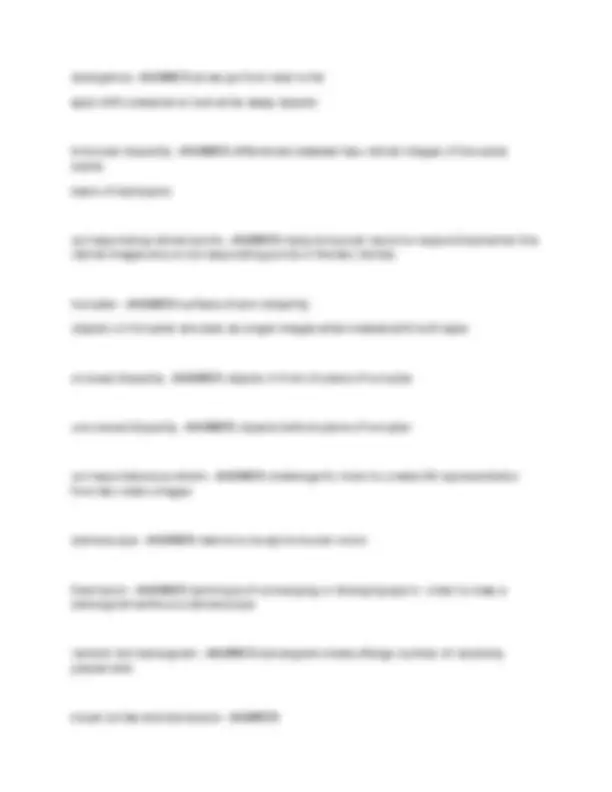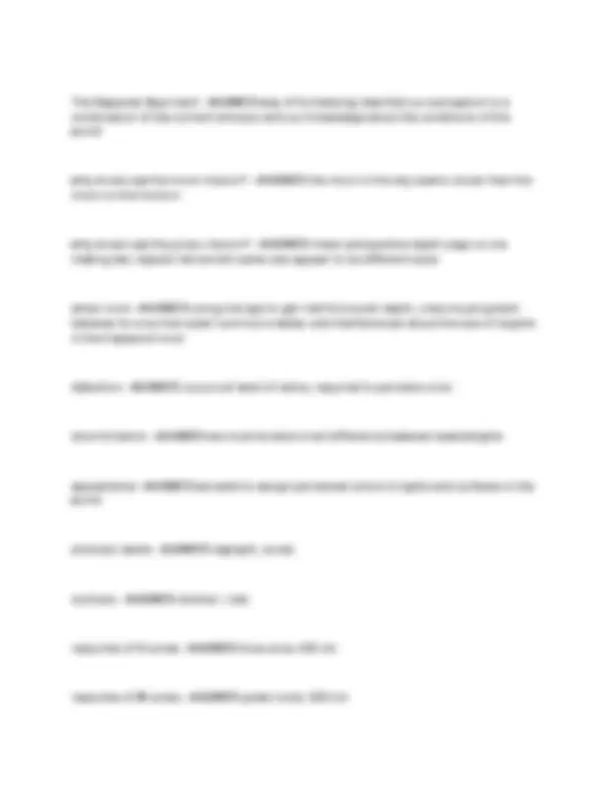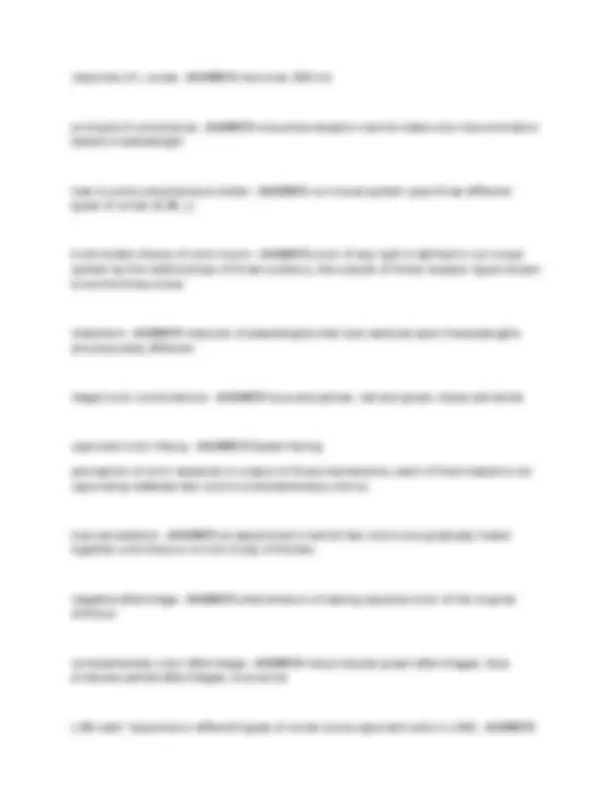





Study with the several resources on Docsity

Earn points by helping other students or get them with a premium plan


Prepare for your exams
Study with the several resources on Docsity

Earn points to download
Earn points by helping other students or get them with a premium plan
Community
Ask the community for help and clear up your study doubts
Discover the best universities in your country according to Docsity users
Free resources
Download our free guides on studying techniques, anxiety management strategies, and thesis advice from Docsity tutors
NEU 394 EXAM QUESTIONS AND CORRECT ANSWERS 100% VERIFIED!!
Typology: Exams
1 / 7

This page cannot be seen from the preview
Don't miss anything!




Inverse Problem - ANSWER brain needs to create 3D representations of the world on tehbasis of 2D inputs
Monocular depth cue - ANSWER requires one eye to perceive depth examples of monocular depth cue - ANSWER relative size and height linear and aerial perspective binocular depth cue - ANSWER requires both eyes to perceive depth metrical depth cue - ANSWER provides information about distance in the thirddimension
examples of metrical depth cue - ANSWER relative size; relative height; texturegradient; familiar size; stereopsis; motion parallax
nonmetrical depth cue - ANSWER gives us relative orderings of occluders and occludedbut not their size or distance
examples of nonmetrical depth cue - ANSWER occlusion and aerial perspective pictorial depth cue vs no pictorial depth cue - ANSWER pictorial depth cues are any infoconveyed to observer of a 2D image that gives the impression of 3D image
relative size - ANSWER comparison of size between items without knowing the absolute
size of either one relative height - ANSWER objects that are higher are further away texture gradient - ANSWER based on geometric fact of same size form smaller, closerspaced images the farther away they get
familiar size - ANSWER knowledge of the typical size of objects aerial perspective - ANSWER based on implicit understanding that light is scattered bythe atmosphere
linear perspective - ANSWER lines that are parallel in 3D world will appear to convergein 2D image as they extend into the distance (vanishing point)
anamorphosis - ANSWER flat image that looks 3D when viewed from correct position occlusion - ANSWER near object can partially occlude another object that is far away motion parallax - ANSWER triangulation cueimages closer to observer move faster across the visual field than images farther away
accommodation - ANSWER triangulation cueprocess bywhich eye changes its focus
convergence - ANSWER as we shift focus from a far to near point moveyour eyes inwards to look at close objects
The Bayesian Approach - ANSWER way of formalizing idea that our perception is acombination of the current stimulus and our knowledge about the conditions of the world why do we see the moon illusion? - ANSWER the moon in the sky seems closer than themoon on the horizon
why do we see the ponzu illusion? - ANSWER linear perspective depth plays a rolemaking two objects hat are teh same size appear to be different sizes
ames room - ANSWER using one eye to get ridof binocular depth, ones visual systembelieves its a normal sized room but creates odd interferences about the size of objects in the trapezoid room detection - ANSWER occurs at level of retina; required to perceive color discrimination - ANSWER we must be able to tell difference between wavelengths appearance - ANSWER we want to assign perceived colors to lights and surfaces in theworld
photopic levels - ANSWER daylight; cones scotopic - ANSWER dimmer; rods response of S cones - ANSWER blue cone; 420 nm response of M cones - ANSWER green cone; 535 nm
response of L cones - ANSWER red cone; 565 nm principle of univariance - ANSWER one photoreceptor cannot make color discriminationbased on wavelength
how to solve univariance problem - ANSWER our visual system uses three differenttypes of cones (S, M, L)
trichromatic theory of color vision - ANSWER color of any light is defined in our visualsystem by the relationships of three numbers, the outputs of three receptor types known to be the three cones metamers - ANSWER mixtures of wavelengths that look identical even if wavelengthsare physically different
illegal color combinations - ANSWER blue and yellow; red and green; black adn white opponent color theory - ANSWER Ewald Hering perception of color depends on output of three mechanisms, each of them based on anopponency between two colors (complementary colors)
hue cancellation - ANSWER an experiment in which two colors are gradually mixedtogether until there is no hint of any of the two
negative afterimage - ANSWER phenomenon of seeing opposite color of the originalstimulus
complementary color afterimage - ANSWER red produces green afterimages; blueproduces yellow afterimages; vice versa
LGN cells' response to different types of cones (cone opponent cells in LGN) - ANSWER
color contrast - ANSWER color is more enhanced when it is near its opponent color examples of color contrast - ANSWER green square looks greener on red backgroundthan on green background
color assimilation - ANSWER two colors bleed into each other, each of them taking onsome of the chromatic qualities of the other
examples of color assimilation - ANSWER brown sphere with green stripes on top willlikely be perceived as green
color constancy - ANSWER tendency of a surface to appear the same oclor under afairly wide range of illuminants
examples of color constancy - ANSWER banana will look yellow in both high and lowluminance
examples of how color perception impacts other perception of other sensory modalities- ANSWER people who drink a purple drink with cranberry flavor reported a grape taste
ways that color can be used in various survival situations - ANSWER notify animals ofdanger
Maxwell's color matching experiment - ANSWER reference color is presented on the left;on the right, observer adjusts mixture of three lights to match the color
additive color mixing - ANSWER taking one wavelength or a set of wavelengths andadding it to another
subtractive color mixing - ANSWER some of the light shining on the surface of two mixedpigments will be subtracted, only the remainder contributes to color